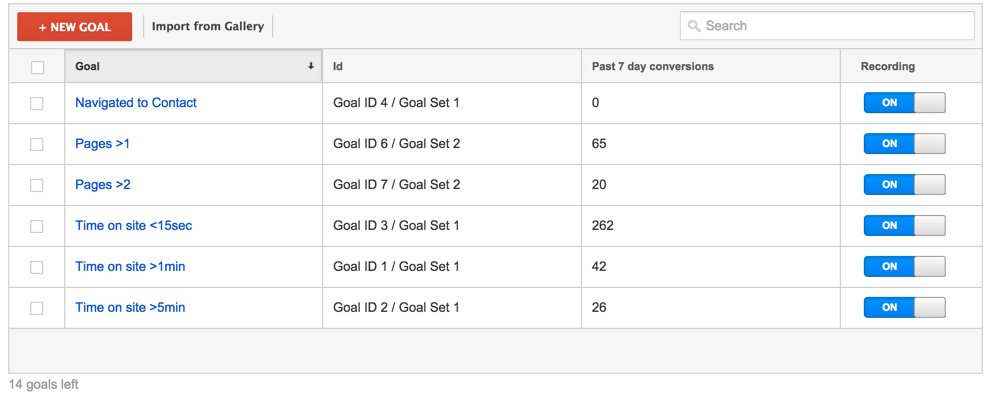Unveiling the Blind Attractions: Understanding What Google Analytics Goals Can not Determine
In the realm of digital analytics, Google Analytics stands as an effective device for tracking and examining online customer communications. Nonetheless, in the middle of its robust abilities, there exist unseen areas that commonly escape dimension. Understanding what Google Analytics objectives can not gauge is important for acquiring an extensive view of individual actions and interaction. As we explore the ins and outs of these blind spots, we reveal a complex web of uncharted territories that hold important insights into individual activities and inspirations, difficult conventional knowledge and shedding light on the constraints of our data-driven understanding.
Individual Habits on External Operatings Systems
Comprehending just how users interact on external systems is essential for optimizing on the internet approaches. Outside systems, such as social media sites networks, recommendation web sites, and on the internet forums, play a considerable function in driving web traffic to a firm's web site. By evaluating user behavior on these platforms, services can acquire useful insights right into the efficiency of their marketing efforts and the choices of their target market.
One trick aspect of user behavior on outside systems is the reference resource. By tracking where the users are coming from, businesses can determine which platforms are driving one of the most traffic to their web site. This information can aid business designate their sources much more efficiently, concentrating on the systems that generate the ideal results.

Offline Communications and conversions
Assessing customer actions on external systems supplies beneficial understandings right into on-line strategies; nevertheless, thinking about offline conversions and communications is equally necessary for a detailed understanding of a firm's general performance. While Google Analytics excels at tracking online communications, it falls short in catching the total consumer trip that often consists of offline touchpoints. Offline conversions, such as in-store acquisitions or phone questions, play a considerable duty in many companies' success. Overlooking these interactions can result in an altered view of the efficiency of advertising projects and overall organization efficiency.

Attribution Beyond Last Click
When diving right into the world of electronic advertising and marketing analytics, it comes to be necessary to look past the solitary touchpoint of the last click for a much more extensive understanding of acknowledgment. While Google Analytics supplies beneficial understandings into user habits, counting only on last-click attribution can be restricting - what data is google analytics goals unable to track. Acknowledgment models that go beyond the last click use an extra nuanced view of the consumer journey, taking into consideration all the touchpoints that lead to a conversion
Attribution past the last click allows marketing professionals to appoint debt to different interactions along the conversion course, giving a clearer photo his explanation of the performance of various advertising and marketing channels. By checking out multi-touch acknowledgment models such as direct, time degeneration, or position-based attribution, businesses can much better assign their advertising budgets and optimize their approaches for maximum impact.
Understanding the impact of each touchpoint in the conversion process is essential for making notified choices and optimizing ROI. By embracing acknowledgment past the last click, services can acquire much deeper understandings right into customer actions and tailor their marketing initiatives much more successfully.
Cross-Device and Cross-Browser Monitoring

Likewise, cross-browser monitoring enhances cross-device monitoring by capturing user behavior as they change in between different web internet browsers. Comprehending just how users communicate with internet sites on different web browsers can assist marketers maximize their online experiences to guarantee uniformity and performance across different systems.
Qualitative Information and Individual Intent
Recognizing customer intent via qualitative information evaluation is crucial for establishing targeted electronic advertising methods that resonate with the demands and preferences of the target audience. Qualitative data gives insights right into the 'why' behind individual activities, losing light on motivations, emotions, and choices that measurable data alone can not capture. By evaluating individual feedback, comments, and interactions, marketing experts can reveal useful info regarding individual intent, enabling them to tailor their messaging, content, and offerings to much better align with what their target market is seeking.
Qualitative data additionally assists in comprehending the context in which individuals involve with a website or app. This contextual understanding allows marketers to create even more pertinent and individualized experiences, ultimately driving greater interaction and conversion find more information rates. By diving right into user intent via qualitative information analysis, services can acquire a deeper understanding of their target market, leading to extra efficient advertising and marketing strategies that fulfill users' requirements and expectations.
Conclusion
To conclude, Google Analytics goals have restrictions in gauging user behavior on outside platforms, offline conversions, attribution beyond last click, cross-browser and cross-device monitoring, and qualitative data connected to customer intent. what data is google analytics goals unable to track. It is necessary for businesses to be conscious of these unseen areas in order to supplement their information evaluation with various other tools and methods to acquire an extra comprehensive understanding of their target market and improve their general digital advertising approaches
By assessing customer habits on these systems, companies can obtain valuable understandings into the effectiveness of their advertising and marketing efforts and the choices of their target audience.
Analyzing customer behavior on outside systems check my site provides beneficial understandings into online methods; nonetheless, thinking about offline conversions and interactions is similarly essential for a thorough understanding of a company's overall performance.In electronic marketing analytics, relocating beyond last-click acknowledgment to check out cross-device and cross-browser tracking is necessary for acquiring a holistic understanding of user interactions throughout numerous platforms and devices. By assessing individual feedback, comments, and interactions, marketing professionals can discover beneficial information concerning user intent, enabling them to customize their messaging, material, and offerings to better align with what their target market is seeking.
By delving into user intent via qualitative data analysis, organizations can acquire a deeper understanding of their target audience, leading to a lot more efficient advertising techniques that fulfill users' needs and expectations.